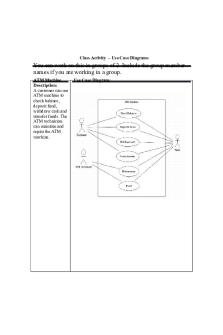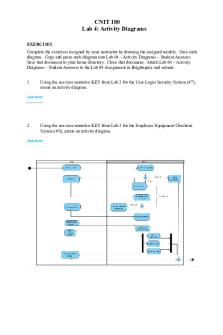Lab 04 - Activity Diagrams - Student Answers PDF

| Title | Lab 04 - Activity Diagrams - Student Answers |
|---|---|
| Author | Eddy Wan |
| Course | Introduction To Systems Development |
| Institution | Purdue University |
| Pages | 6 |
| File Size | 368.8 KB |
| File Type | |
| Total Downloads | 44 |
| Total Views | 146 |
Summary
Download Lab 04 - Activity Diagrams - Student Answers PDF
Description
CNIT 180 Lab 4: Activity Diagrams EXERCISES Complete the exercises assigned by your instructor by drawing the assigned models. Save each diagram. Copy and paste each diagram into Lab 04 – Activity Diagrams – Student Answers. Save that document to your home directory. Close that document. Attach Lab 04 – Activity Diagrams – Student Answers to the Lab 04 Assignment in Brightspace and submit. 1.
Using the use case narrative KEY from Lab 3 for the User Login Security System (#7), create an activity diagram.
Answer:
2.
Using the use case narrative KEY from Lab 3 for the Employee Equipment Checkout System (#8), create an activity diagram.
Answer:
CNIT 180 Lab 4: Activity Diagrams 3.
Using the narrative below, create an activity diagram. A customer makes an appointment with an eye doctor. The eye doctor performs an examination. The eye doctor prepares the prescription. The customer goes to the eye glasses store. The customer selects the frame. The customer selects the lenses. The eye glass store constructs the glasses. The customer tries them on. If they fit the customer pays for them and goes home. If they don’t fit, the eye glasses store adjusts the fit and the customer tries them back on. The previous step is repeated until the glasses fit.
Answer:
CNIT 180 Lab 4: Activity Diagrams 4.
Using the use case narrative below, create an activity diagram.
ATM System Author: Barlow, Victor M. Use-Case Name: Use-Case ID: Priority: Source: Primary Business Actor: Primary System Actor: Other Participating Actors: Other Interested Stockholders: Description:
Precondition: Trigger: Typical Course Of Events:
Make ATM deposit to checking account Lab 4 – Problem 4 Normal Lab Manual Patron
Date: 08/11/2015 Use Case Type Business Requirements: System Analysis: System Design:
ATM Manager A patron arrives at the ATM machine with the intention to make a deposit. The ATM requests the card, PIN, deposit amount, deposit envelope, and then dispenses a receipt & the card. The patron has a valid ATM card and PIN and open checking account. The patron inputs their ATM card into the ATM machine. Actor Action System Response
CNIT 180 Lab 4: Activity Diagrams STEP 1: The patron inputs their ATM card (containing their account #) into the ATM machine. STEP 4: The patron inputs their PIN.
STEP 7: The patron selects DEPOSIT. STEP 9: The patron inputs the deposit amount. STEP 11: The patron enters the deposit envelope containing the deposit.
STEP 2: The system verifies that the card is valid. STEP 3: The system prompts for the PIN. STEP 5: The system verifies the PIN is valid for the account number on the card. STEP 6: The system prompts the user for the type of transaction desired. STEP 8: The system prompts the patron to enter the amount to be deposited. STEP 10: The system prompts the patron to enter the deposit envelope. STEP 12: The system logs the transaction, updates the patron’s account, marks the envelope, (the previous three actions are done at the same time), and then dispenses the card and a receipt.
STEP 13: The patron takes the card & receipt and leaves. Alternate Courses: Conclusion: Postcondition: Business Rules: Implementation Constraints and Specifications: Assumptions: Open Issues:
5.
ALT-STEP 2: The card is NOT valid, notify patron and cancel the transaction. ALT-STEP 5: The PIN is NOT valid for that card, GO TO STEP 3. This use case concludes when the deposit has been completed and the patron receives their card & receipt. The deposit has been recorded.
Using the use case narrative below, create an activity diagram. PU Banking System
Author: Barlow, Victor M. Use-Case Name: Use-Case ID: Priority: Source: Primary Business Actor: Primary System Actor: Other Participating Actors: Other Interested Stockholders: Description: Precondition: Trigger:
Apply for a bank account Lab 4 – Problem 5 Normal Lab Manual Potential Customer (initiating actor) Customer (receiver of something of value) Bank Manager (transaction facilitator)
Date: 08/11/2015 Use Case Type Business Requirements: System Analysis: System Design:
Credit Bureau
This use case describes the process that a potential customer goes through to apply for a bank account which can be either checking, savings, or both. Manager has logged on to the bank account management system. This use case is initiated when the potential customer submits an application to the bank manager to open a bank account.
CNIT 180 Lab 4: Activity Diagrams Typical Course Of Events:
Actor Action STEP 1: The use case is initiated when the potential customer submits an application for an account to the bank manager. STEP 2: The bank manager reviews the application for any errors or omissions. STEP 3: The bank manager selects the option to open a new bank account. STEP 5: The bank manager provides the new account information.
STEP 8: The credit bureau processes the request and responds with the credit report and score. STEP 10: The bank manager reviews the credit report to ensure credit worthiness. STEP 11: The bank manager approves the account.
System Response
STEP 4: The system responds by prompting the user for the new account information (name, address, DOB, phone number, SSN, account type). STEP 6: The system responds by verifying the new account information in terms of data and format checking. STEP 7: The system responds by submitting a request to the credit bureau for a credit report and associated score. STEP 9: The system responds by displaying the credit report information to the bank manager and prompts them for an approval.
STEP 12: The system responds by generating an account number. STEP 13: The system stores the account information. STEP 14: The system generates an account identification card which is given to the customer.
STEP 15: The use case concludes when the customer receives their new account information and their card. Alternate Courses:
Conclusion: Postcondition:
Business Rules: Implementation Constraints and Specifications: Assumptions: Open Issues:
ALT-STEP 2: The bank manager finds omissions or errors on the application and requests the potential customer to correct them. GOTO STEP 1. ALT-STEP 6: The system verifies the new account information in terms of data and format checking and finds errors. The system responds by displaying the error and then prompts the bank manager to correct them. GOTO STEP 5. ALT-STEP 11: The bank manager denies the application for a bank account. The system stores the application as rejected and then generates a letter stating the reasons the application was rejected, and then the letter is sent to the potential customer. Cancel transaction. This use case concludes when the customer receives their new account information and their card. The post condition of this use case is that the potential customer is given approval for a new bank account after the proper credit checks have been performed and now is considered a customer of the bank. Their account information is stored in the system. OR the potential customer are denied a new account and the reasons why are communicated and documented.
CNIT 180 Lab 4: Activity Diagrams...
Similar Free PDFs

UML diagrams activity
- 6 Pages

Sequence & Activity Diagrams
- 4 Pages

Answers to lab activity 45
- 41 Pages

Lab 10 - HR Diagrams
- 3 Pages

Lab Practical 2 Diagrams
- 17 Pages

DNA Profiling Activity Student
- 8 Pages

Lab 10 - Free Body Diagrams
- 7 Pages

04 Activity 1(5)-AST
- 5 Pages

Tutorial 04 Answers - tute
- 6 Pages

Active Reading Guide Activity 04
- 12 Pages

Chapter 04 Answers
- 25 Pages

SP101 Activity for every student
- 2 Pages
Popular Institutions
- Tinajero National High School - Annex
- Politeknik Caltex Riau
- Yokohama City University
- SGT University
- University of Al-Qadisiyah
- Divine Word College of Vigan
- Techniek College Rotterdam
- Universidade de Santiago
- Universiti Teknologi MARA Cawangan Johor Kampus Pasir Gudang
- Poltekkes Kemenkes Yogyakarta
- Baguio City National High School
- Colegio san marcos
- preparatoria uno
- Centro de Bachillerato Tecnológico Industrial y de Servicios No. 107
- Dalian Maritime University
- Quang Trung Secondary School
- Colegio Tecnológico en Informática
- Corporación Regional de Educación Superior
- Grupo CEDVA
- Dar Al Uloom University
- Centro de Estudios Preuniversitarios de la Universidad Nacional de Ingeniería
- 上智大学
- Aakash International School, Nuna Majara
- San Felipe Neri Catholic School
- Kang Chiao International School - New Taipei City
- Misamis Occidental National High School
- Institución Educativa Escuela Normal Juan Ladrilleros
- Kolehiyo ng Pantukan
- Batanes State College
- Instituto Continental
- Sekolah Menengah Kejuruan Kesehatan Kaltara (Tarakan)
- Colegio de La Inmaculada Concepcion - Cebu



